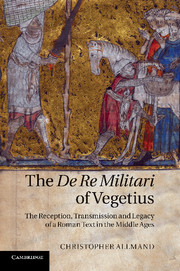 The De Re Militari of Vegetius
The De Re Militari of Vegetius from Part II - The transmission
Published online by Cambridge University Press: 07 October 2011
The De re militari was one of the first classical texts to become available in printed form. The seven imprints (eight if Hohenwang's German translation is included) which qualify as incunables (pre-1501) leave no doubt that the work was regarded as a most marketable commodity. It is likely that the first printing was made by Nicolaus Ketelaer at Utrecht, perhaps in 1473–74. The text, referred to at the end as the ‘Epitoma de re militari’, was said to be the work of Flavii Vedati Renati. It is a fine edition, stark in its simplicity (it lacks any kind of title page or information about the printer and the date of printing), the black print having retained its colour to this day. Large capital letters are in blue (in the British Library copy) or in red (in the Bibliothèque nationale de France and Bodleian Library copies; the John Rylands University Library of Manchester copy has no colour); smaller letters are in red. In Book IV, chapters 38 and 40, there are gaps for Greek words; presumably the fount was not yet available. The volume lacks all illustrative material.
This edition was soon to be followed by another, the Epithomia rei militaris, in folio, prepared by Nicolaus Götz (‘N.G’.), who worked in Cologne (where Caxton was to learn the printing trade) about 1475. Götz was active between 1474 and 1480, printing mainly theology and a Latin Bible. His De re militari was set in two columns, with spaces left for capital letters, which, in the copies now in Paris, are in red. Like the Ketelaer imprint, the text has no heading. The Bodleian copy has handwritten pagination/foliation, running from 357 to 394, added at the top of each folio, which suggests that this copy once formed part of a larger volume. The British Library copy is bound with the De viris illustribus of Jerome, which follows Vegetius’ text. The Manchester copy has book and chapter headings added by hand at the top of some pages, presumably to facilitate ease of use. It is noticeable that the heading for I, 28, is printed ‘De ordinacione rei militaris’ rather than the correct ‘De adhortatione rei militaris’.
To save this book to your Kindle, first ensure no-reply@cambridge.org is added to your Approved Personal Document E-mail List under your Personal Document Settings on the Manage Your Content and Devices page of your Amazon account. Then enter the ‘name’ part of your Kindle email address below. Find out more about saving to your Kindle.
Note you can select to save to either the @free.kindle.com or @kindle.com variations. ‘@free.kindle.com’ emails are free but can only be saved to your device when it is connected to wi-fi. ‘@kindle.com’ emails can be delivered even when you are not connected to wi-fi, but note that service fees apply.
Find out more about the Kindle Personal Document Service.
To save content items to your account, please confirm that you agree to abide by our usage policies. If this is the first time you use this feature, you will be asked to authorise Cambridge Core to connect with your account. Find out more about saving content to Dropbox.
To save content items to your account, please confirm that you agree to abide by our usage policies. If this is the first time you use this feature, you will be asked to authorise Cambridge Core to connect with your account. Find out more about saving content to Google Drive.